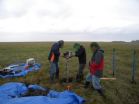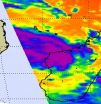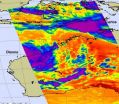(Press-News.org) Northwestern University scientists have discovered a new mechanism in the core gears of the circadian clock. They found the loss of a certain gene, dubbed "twenty-four," messes up the rhythm of the common fruit fly's sleep-wake cycle, making it harder for the flies to awaken.
The circadian clock drives, among other things, when an organism wakes up and when it sleeps. While the Northwestern study was done using the fly Drosophila melanogaster, the findings have implications for humans.
The research will be published Feb. 17 in the journal Nature.
"The function of a clock is to tell your system to be prepared, that the sun is rising, and it's time to get up," said Ravi Allada, M.D., who led the research at Northwestern. "The flies without the twenty-four gene did not become much more active before dawn. The equivalent in humans would be someone who has trouble getting out of bed in the morning."
Allada is professor of neurobiology and physiology in the Weinberg College of Arts and Sciences and associate director for the Center for Sleep and Circadian Biology.
Period (per) is a gene in fruit flies that encodes a protein, called PER, which regulates circadian rhythm. Allada and his colleagues found that twenty-four is critically important to producing this key clock protein. When twenty-four is not present very little PER protein is found in the neurons of the brain, and the fly's sleep-wake rhythm is disturbed.
It seems it was fate that the gene Allada and his team pinpointed would be important in regulating the 24-hour sleep-wake cycle. The gene's generic name is CG4857, and the numbers add up to 24, earning it the twenty-four nickname. (The fruit fly's genome was sequenced in 2000, but until now the function of this gene was unknown.)
The known core mechanisms of the circadian clock, both in flies and humans, involve the process of transcription, where RNA is produced from DNA. A portion of the control system called a transcriptional feedback loop also is important. (The word circadian comes from the Latin phrase "circa diem," meaning "about a day.")
In trying to identify new clock components, the researchers identified a new player in the system, the gene twenty-four. Instead of operating in the process of transcription, they found twenty-four operates in the process of translation: translating proteins from RNA.
Twenty-four appears to be a protein that promotes translation of period RNA to protein. "This really defines a new mechanism by which circadian clocks are functioning," Allada said. "We found that twenty-four has a really strong and critical role in translating a key clock protein. Translation really wasn't appreciated before as having such an important role in the process."
The researchers believe it is likely that a mechanism similar to that described for the fly gene twenty-four will be evolutionarily conserved and found in humans.
Allada and his Northwestern team worked with scientists at the Korea Advanced Institute of Science and Technology (KAIST). Using a Drosophila library at KAIST, the researchers first screened the behavior of 4,000 different flies looking for flies whose sleep-wake cycles were awry. (Each fly had a different overexpressed gene and thus different behavior.) The fly with the most dramatic change was one with a longer cycle than normal, 26 hours instead of 24.
The overexpressed gene in this fly was CG4857. The researchers next removed, or knocked out, this gene in the flies. These flies had very poor sleep-wake rhythm and would sleep and wake at all times of day. The researchers found very little of the critical PER protein in the brain neurons despite the fact that per RNA is likely produced in the neurons. Without twenty-four the RNA was not translated into the PER protein, leading to dysfunction.
INFORMATION:
The paper is titled "The Novel Gene Twenty-four Defines a Critical Translational Step in the Drosophila Clock." In addition to Allada, other authors of the paper Chunghun Lim and Valerie L. Kilman, from Northwestern; Jongbin Lee, Changtaek Choi, Juwon Kim and Joonho Choe, from Korea Advanced Institute of Science and Technology, Korea; and Sung Mi Park and Sung Key Jang, from Pohang University of Science and Technology, Korea.
END
Up to two-thirds of Earth's permafrost likely will disappear by 2200 as a result of warming temperatures, unleashing vast quantities of carbon into the atmosphere, says a new study by the University of Colorado Boulder's Cooperative Institute for Research in Environmental Sciences.
The carbon resides in permanently frozen ground that is beginning to thaw in high latitudes from warming temperatures, which will impact not only the climate but also international strategies to reduce fossil fuel emissions, said CU-Boulder's Kevin Schaefer, lead study author. "If we want ...
VIDEO:
Nobody enjoys colonoscopies, including mice. University of Missouri researchers are excited about the potential of using genetic biomarkers to predict colon cancer caused by inflammation. A new method developed at...
Click here for more information.
COLUMBIA, Mo. – Nobody enjoys colonoscopies, including mice. University of Missouri researchers are excited about the potential of using genetic biomarkers to predict colon cancer caused by inflammation. A new method developed ...
WASHINGTON—February 16, 2011—Despite the unpredictable economy, nearly three-quarters (73%) of New Jersey residents think spending money on research to improve health globally is important to jobs and incomes in the state, according to a new statewide poll commissioned by Research!America. The poll data will be released today at a meeting in Washington, DC, of prominent global health research and development (R&D) experts and New Jersey business, academia and nonprofit leaders. This is part of a six-state effort by Research!America.
According to the poll, most of the ...
The California Health Interview Survey (CHIS), the nation's largest state health survey and a primary source of information on California's diverse population, released its latest data today on more than 100 topics affecting the health and well-being of the state's residents.
The random–digit-dial telephone survey, conducted every two years by the UCLA Center for Health Policy Research, gathers essential information from tens of thousands of California households on a wide variety of topics, from health insurance and public program participation to diabetes, obesity ...
Infrared satellite data from NASA is showing some strong thunderstorms over west-central Madagascar today as Tropical Storm Bingiza continues to hug the western coast of the island nation.
The Atmospheric Infrared Sounder (AIRS) instrument that flies aboard NASA's Aqua satellite captured an infrared image of Tropical Storm Bingiza today, Feb. 16 at 10:17 UTC (5:17 a.m. EST). The image revealed some strong convection over the west-central coast where thunderstorm cloudtops were high and dropping moderate to heavy rainfall. Infrared data can provide temperature information ...
NASA's Aqua satellite captured an infrared image today of tropical cyclones affecting Australia in the western and northern areas of the country. Newly formed Tropical Storm Carlos is bringing heavy rains and gusty winds to Darwin and the Northern Territory, while Tropical Storm Dianne is bringing rains and winds to Western Australia.
NASA's Aqua satellite passed over Australia today, Feb. 16 at 05:17 UTC (12:17 a.m. EST/ 2:47 p.m. Australia/Darwin local time. The Atmospheric Infrared Sounder (AIRS) instrument captured an infrared image of both tropical storms and found ...
ESA's Herschel space observatory has discovered a population of dust-enshrouded galaxies that do not need as much dark matter as previously thought to collect gas and burst into star formation.
The galaxies are far away and each boasts some 300 billion times the mass of the Sun. The size challenges current theory that predicts a galaxy has to be more than ten times larger, 5000 billion solar masses, to be able form large numbers of stars.
The new result is published today in a paper by Alexandre Amblard, University of California, Irvine, and colleagues.
Most of the ...
A recent multicenter clinical trial of atorvastatin, a type of cholesterol-lowering drug, found that although the drug did not inhibit plasma HIV RNA levels, it did inhibit expression of cellular markers of immune activation and inflammation in patients with HIV infection. Since immune activation and inflammation are associated with progression of HIV infection, the implication is that the statin may inhibit disease progression and help in the infection's management. The findings are in a study, available online, published in The Journal of Infectious Diseases.
The investigators, ...
As a child grows, a short stature is not usually cause for concern, but it is often the only sign of a condition called Turner syndrome. Prevalent in girls, Turner syndrome is a genetic defect that short-circuits normal growth and leads to cardiac and renal problems. It is not commonly detected until age 10 or older when a youngster's unusually short height raises suspicions.
This lag before diagnosis of the condition can delay the start of growth hormone therapy, which can help in achieving normal or near-normal adult stature. Yale School of Medicine researchers are ...
A readily available, inexpensive drug therapy showed a significant benefit in treating premature infants with the worst and historically most difficult-to-treat cases of retinopathy of prematurity.
The results of a multicenter clinical trial led by researchers at The University of Texas Health Science Center at Houston (UTHealth) are published in the Feb. 17 issue of The New England Journal of Medicine.
Retinopathy of prematurity is a leading cause of childhood blindness worldwide. In the immature retina of babies born before 30 weeks' gestational age, the disease results ...




